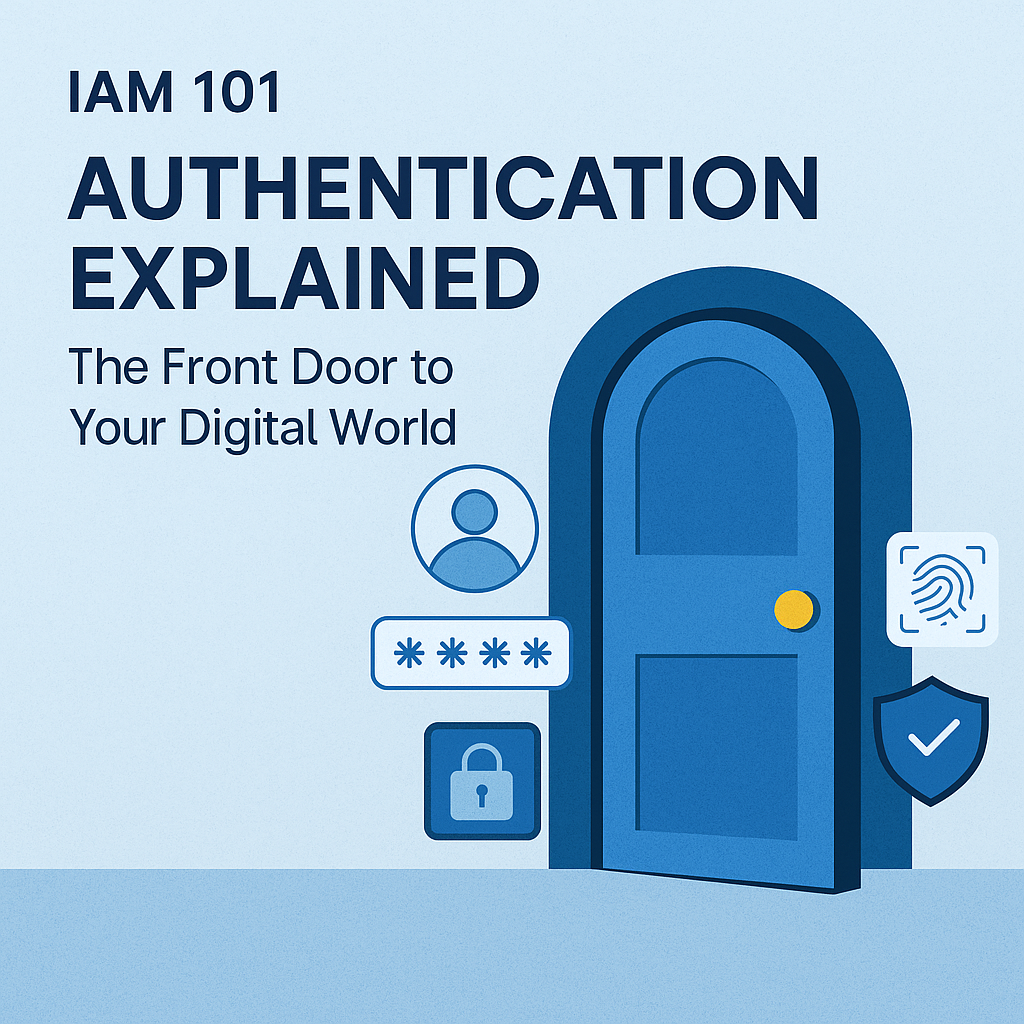
TL;DR
Authentication is the process of verifying that users are who they say they are. It’s the gatekeeper to every digital system, and when done poorly, it becomes the #1 way attackers break in. From passwords to biometrics to FIDO2, authentication has evolved into a key pillar of Zero Trust security. In this post, we’ll explore:
- How authentication works
- Different types (and what’s still worth using)
- Best practices for IT teams
- How AI, phishing, and automation are shifting the landscape
🔍 Background
After 15 years working in Identity and Access Management, I can confidently say: authentication is where security begins—or where it breaks down.
It’s the “front door” to every SaaS tool, server, admin panel, and application your users interact with. And just like your house, if you leave the front door wide open (or protected by a flimsy lock), don’t be surprised if someone walks right in.
According to Verizon’s 2023 Data Breach Investigations Report, over 80% of hacking-related breaches involved stolen or weak credentials. The problem isn’t new, but the stakes are getting higher as threats grow more targeted—and tools more automated.
So, let’s talk about what authentication is, how it’s changing, and what IT pros like you can do to get it right.
🧠 What Is Authentication?
Authentication is the process of proving that you are who you claim to be before accessing a digital system. It precedes authorization (what you can do once inside) and is a non-negotiable first step in any secure architecture.
The Classic Formula:
Authentication typically relies on one or more of the following factors:
| Factor Type | Description | Examples |
|---|---|---|
| Something you know | A shared secret | Passwords, PINs |
| Something you have | A physical or digital token | Smart card, phone, hardware key |
| Something you are | A biometric identifier | Fingerprint, face scan, voice |
| Somewhere you are | Contextual factor (location) | GPS-based access limits |
| Something you do | Behavioral analysis | Typing cadence, device use |
The strength of your authentication setup depends on the mix of these factors. Using just one? That’s single-factor authentication. Using two or more? Welcome to MFA—a must-have in 2025.
🔐 Why It’s More Than Just Passwords
Passwords are the oldest form of digital authentication—and still the most common. But let’s be honest: they’re also the weakest.
People reuse passwords across systems, choose easily guessable strings (like “Welcome1!”), or store them in insecure ways. Even IT pros are guilty of “temporary” shared passwords that never get rotated.
Enter modern authentication practices:
🔑 Multi-Factor Authentication (MFA)
Combines two or more types of authentication factors. A password + a mobile push notification is now the baseline for secure access.
🔏 Passwordless Authentication
With FIDO2/WebAuthn, users authenticate using secure public/private key pairs without typing anything. Think Windows Hello or YubiKeys.
🧠 Adaptive Authentication
AI or rule-based systems that consider context (IP, time of day, geolocation, risk signals) to allow or challenge logins dynamically.
🧪 Types of Authentication Methods (Pros and Cons)
| Method | Description | Pros | Cons |
|---|---|---|---|
| Passwords | Most common, “something you know” | Familiar, simple | Weak, phishable, reused |
| MFA via SMS | OTP sent by text | Better than nothing | Susceptible to SIM swapping |
| TOTP Apps | Code-generating apps (e.g., Authy, Google Authenticator) | More secure than SMS | Still manually entered |
| Push Notifications | Approve login via phone app | Fast, user-friendly | Susceptible to MFA fatigue attacks |
| FIDO2/WebAuthn | Secure token-based auth (YubiKey, FaceID) | Phish-proof, passwordless | Requires newer tech |
| Biometrics | Face/fingerprint unlock | Frictionless, secure | Privacy risks, spoofable in rare cases |
Rule of thumb: use the strongest method available without destroying user experience. Security is only effective if people don’t try to bypass it.
⚙️ Implementation: What IT Teams Need to Consider
Rolling out authentication isn’t just picking a method—it’s configuring it well, integrating it broadly, and monitoring it continuously.
Here’s what I advise based on real-world deployments:
1. Start with Critical Apps
Enforce MFA on email, HR, and finance tools first. These are your crown jewels.
2. Support Passwordless Where Possible
Modern IdPs like Okta, Entra, and Ping now support WebAuthn. Start small—like enabling it for privileged users—and scale from there.
3. Mitigate MFA Fatigue
Use context-aware policies to reduce unnecessary prompts. Prompt only when risk changes (e.g., new location or device).
4. Educate End Users
Explain why they’re being prompted. Security is a partnership, not a punishment.
5. Log Everything
Authentication events are gold during incident response. Make sure you’re capturing success/failure logs, device metadata, and location data.
📈 AI and the Future of Authentication
The authentication landscape is evolving fast—and AI is both a threat and an opportunity.
🚨 Threat: Smarter Phishing
AI can now generate incredibly convincing login pages and spearphishing messages. Credentials are being harvested faster than ever.
🛡️ Opportunity: Smarter Defense
Behavioral biometrics and AI-driven anomaly detection are helping identity platforms detect and stop threats in real time—before passwords are compromised.
📚 Cited Study
In a 2022 study by the FIDO Alliance, 67% of IT professionals said their organization planned to implement passwordless authentication in the next 12–18 months. Yet only 26% had actually done so—highlighting the gap between intent and execution.
(Source: FIDO Alliance “State of Passwordless Security 2022”)
🧭 Final Thoughts
Authentication might seem like a checkbox—but it’s the most important control in IAM. You can’t authorize or audit what you can’t identify.
As IT pros, our job is to build an authentication experience that’s:
- Strong enough to stop attackers
- Simple enough to keep users compliant
- Smart enough to adapt to modern threats
In future posts, we’ll explore how authentication ties directly into SSO, Zero Trust enforcement, and governance reviews.
🚀 Up Next:
IAM 101: RBAC, ABAC, and PBAC – Choosing the Right Access Model